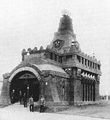Budapest Millennium Exhibition 1896

The Budapest Millennium Exhibition in 1896 was a national exhibition held on the occasion of the millennium celebrations of the Magyar conquest .
history
It was open from May 2, 1896 to October 31, 1896 and attracted approximately 5.2 million visitors.

The location of the exhibition was the Budapest City Park ( Városliget ). Vajdahunyad Castle was built there on the occasion of the exhibition. It comprised the central historical part of the exhibition and showed around 20,000 art objects, mostly from the property of the nobility. In the center was the throne chair on which the emperor, often referred to as Árpád II that year , had signed the compromise with which the Habsburg state became a dual monarchy. In the park area of the Városliget were the pavilions of leading industrial companies, for example the companies Ganz, Mauthner, von Dynamit Nobel , Urikány Zsilvölgy (coal mining), the Thonet brothers , the cement factories Miska Kramer and Robert Wünsch, the sparkling wine factories Törley and Willibaldokratischer Agricultural companies as well as large arbors. The ethnographic aspect was covered by a village with 26 farmhouses from different parts of Hungary and a “pavilion of primary occupations” (hunting and fishing). Numerous festivities and events took place as part of the state exhibition (initially even a world exhibition was planned). The exhibition area was accessed by the Budapest Metro (Földalatti Vasút), the first underground train on mainland Europe.
Selected buildings from the Millennium Exhibition
literature
- Katalin Sinkó: The Millennium Celebration of Hungary in: The Age of Emperor Franz Joseph , Part 2, 1880–1916, Exhibition Catalog, Volume 1 (Articles), p. 295ff, Vienna 1987.
Web links
- Exhibition newspaper No. 1 of Pester Lloyd , May 3, 1896, according to ANNO
- Extract from Ilona Sárány-Parsons
- Timea Galambos, diploma thesis University of Vienna: Magyar Millennium 1896. The bright and dark sides of the Hungarian millennium . Vienna 2008. Last accessed May 27, 2014.











